Eskimo and Indian Games from Alaska
During his recent expedition through Alaska in the interest of the Philadelphia Free Museum of Science and Art, Dr. George B. Gordon kindly collected for me twenty-two interesting string games of the Eskimos and Tanana (Athapascan) Indians. Unfortunately, this book was in type and ready for the press when I learned these figures, therefore I can now give only the drawings of the finished patterns, and a few notes concerning the methods and their relations to the methods used in the figures already described. Of the eighteen Eskimo figures, eight begin with Opening A and ten with new openings; of the four Tanana figures, two begin with Opening A, one with a new opening, and one with the opening of the Eskimo "Mouth." One of the Eskimo figures—the "Wolverine" or the "Wolf"—is in all respects similar to the Klamath "Porcupine," and the "Dog on a Leash," although beginning with a new opening, is otherwise the same as the "Porcupine." The "Cariboo" is precisely the same as the "Cariboo" described by Boas from Baffin-Land. The finished pattern of the "Trap" is identical with the final pattern of the Eskimo "Mouth," but is formed by entirely different methods. One of the Tanana games, the "Bow-String," comes out like the Osage "Thumb Catch," but is otherwise very different. "Crow's Feet" is the familiar "Leashing of Lochiel's Dogs"; the methods, however, are novel and very simple: Lay the loop across your lap, with the two strings parallel and uncrossed; pass each little finger away from you under the near string (the hands being about a foot apart), then pass each index from the far side toward you under the far string; draw this string toward you and pick up the near string on the back of the index, from below and from the near side. Then, sweeping each hand outward, pick up from the near side and from below, on the ball of the index, that part of the far string which, lying on your lap, extends to the right and left of the hands; draw this string toward the centre and bring it up between the two strings passing from hand to hand, letting the loop already on the index slip off, and extend the figure on the index and little fingers.
Many of the methods employed in these hgures are new and difficult; among the familiar ones We find Klamath and Navaho movements; one figure begins with the opening of the Loyalty Islands "Well," and another with the opening of the "Leashing of Lochiel's Dogs." We find no instance of the typical Caroline Islands extension of the finished pattern, and no record of the occurrence of the "Real Cat's-Cradle." At Nunivak Island, the Eskimo name for a cat's-cradle string is ayahaak, "play string," and for the game itself, ayahowsit, "play with a string."
Eskimo Figures
(1) "A Ship," umiakbuk (Fig. 806), from King Island, near Cape Prince of Wales. A further development of the figure forms "Two Men" (Fig. 807).

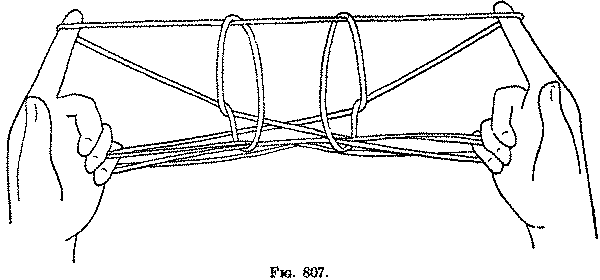
(2) "Two Mountains and a Stream," tituchtak (Fig. 808), from St. Michael Island.
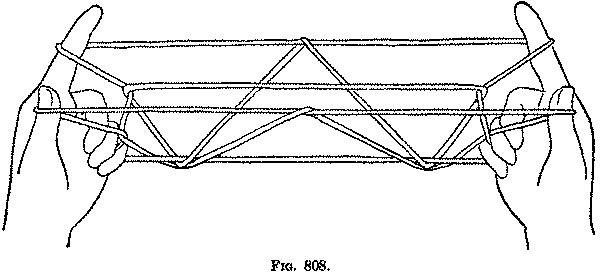
(3) "Arms," moguk (Fig. 809), from which are formed "Legs," eruk (Fig. 810), from Numvak Island.
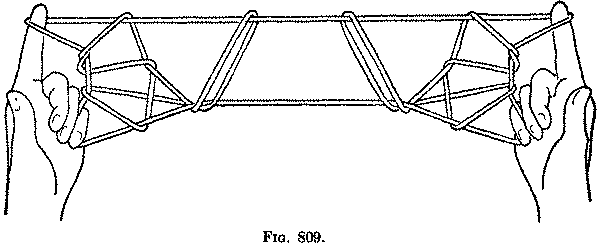
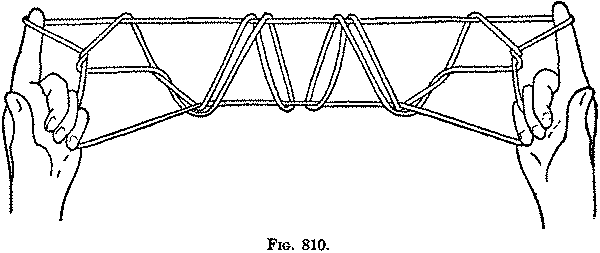
(4) "Siberian House," kochlinee (Fig. 811), and afterward "Two Eskimos Running Away," mugalonik enuck okparuktuk (Fig. 812), from Big Diomede Island.

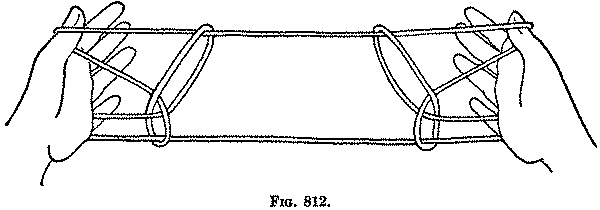
(5) "Wolverine," koftsick, from Cape Prince of Wales; also known as the "Wolf," kulonik. The same as the "Porcupine".
(6) "Little Boat," kayak (Fig. 813), from King Island. The Eskimos say this figure should be called "Two Boats," malruk-kayak, because two men are plainly visible; and as a kayak will hold only one man there must be two boats.
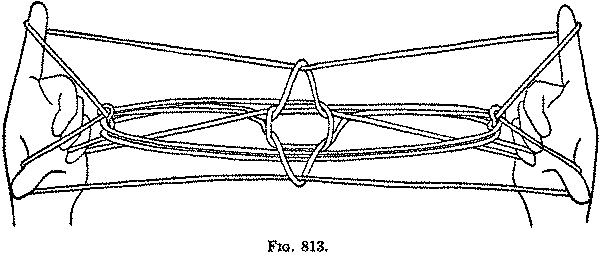
(7) "Sea-Gull," tc-c-kyack (Fig. 814), from Nunivak Island.
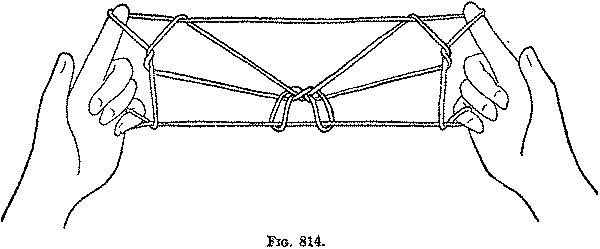
(8) "Lake Fish," nanvumcheseah (Fig. 815), from Anvik, on the Yukon River.
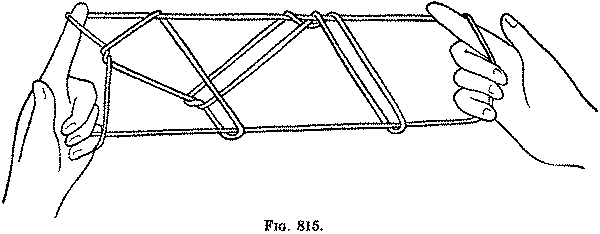
(9) "Stairs," tutumukaligat (Fig. 816), from Cape Prince of Wales.
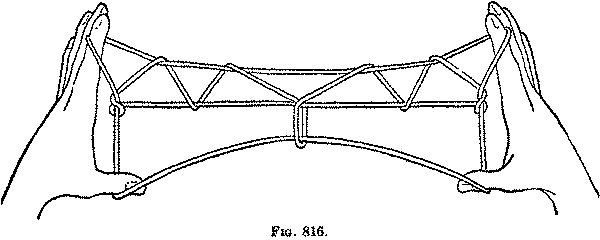
(10) "Clothes Line," iniarat (Fig. 817), from Cape Prince of Wales.
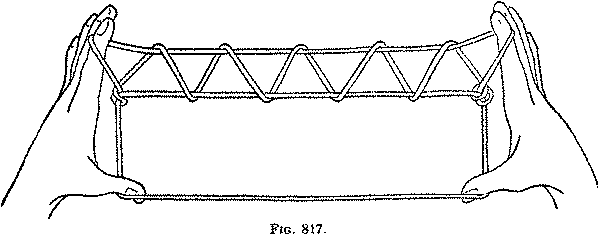
(11) "Rabbit," makadok (Fig. 818), from Anvik, on the Yukon River. It is known on St. Michael Island as "Bird on Eggs."
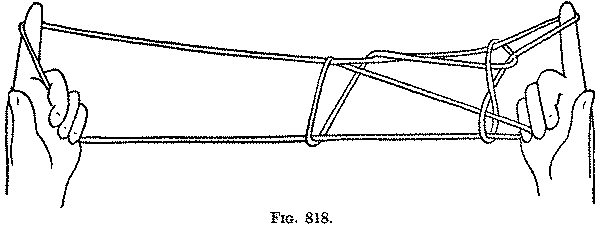
(12) "Whale and Fox," achvuk-tezeuk (Fig. 819), from Cape Prince of Wales. The whale is stranded on the shore and the fox comes to eat it, but an Eskimo drives it away.
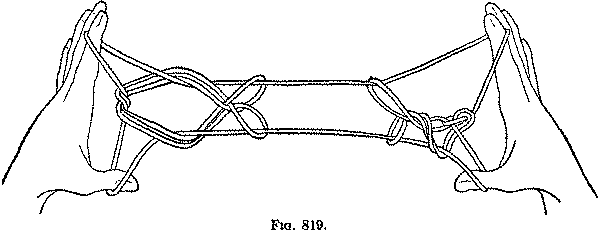
(13) "Dog on a Leash," kaymuchta (Fig. 820), from Nunivak Island. The leash is pulled off and the dog escapes.
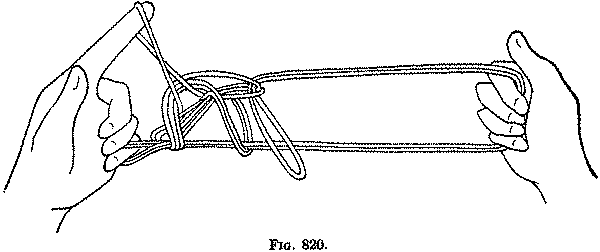
(14) "Nameless" (Fig. 821), from King Island.
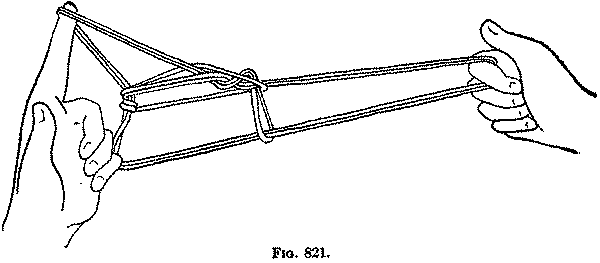
(15) "Sealskin Carrying-bag," aginuk (Fig. 822), from St. Michael Island; afterward are formed the "Kidneys," taktuk (Fig. 823).
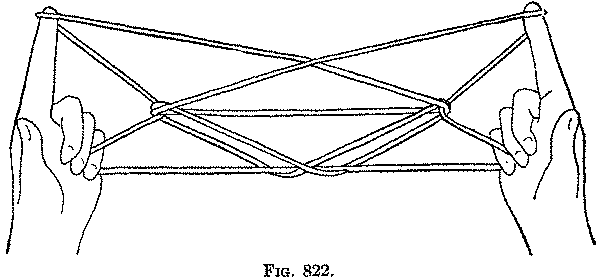
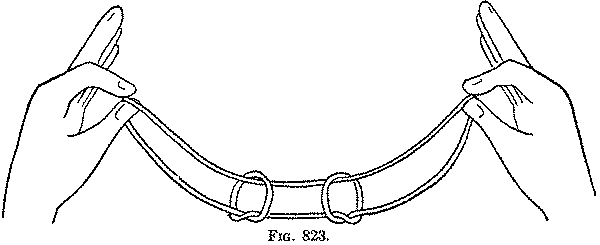
(16) "Two Ptarmigans," mugalonik-okhozgiuk (Fig. 824), from Cape Prince of Wales.
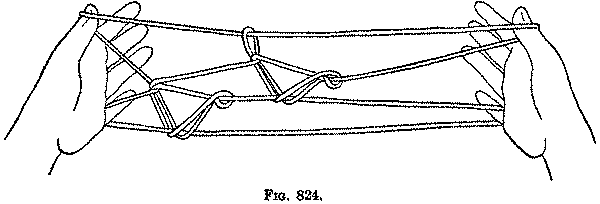
(17) "A Trap," keezook, from Cape Prince of Wales. The final pattern is the same as the "Mouth". The finger, caught in the trap, can be worked out between the strings forming the sides of the trap.
(18) "Cariboo," tuk-tuk, from St. Michael Island. The same as the Baffin-Land "Cariboo".
Tanana Figures
(1) "Bow-String," which comes out like the Osage "Thumb Catch."
(2) "Raven's Feet" (Fig. 825).
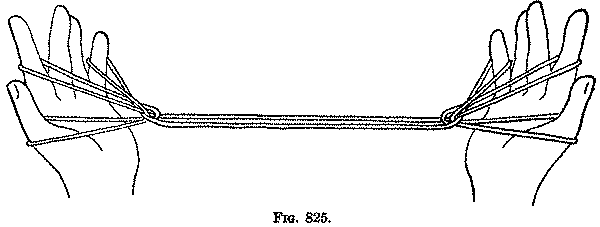
(3) "New Mittens," ajakailaiguk (Fig. 826).
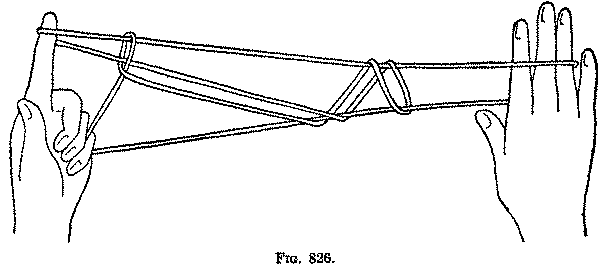
(4) "Crow's Feet." The same as the "Leashing of Lochiel's Dogs."
Figures Known Only from the Finished Patterns
Before it seemed possible to record the method of making string figures a few observers had collected the finished patterns and either made drawings of them or preserved the actual string figures by fastening them on paper. I have brought together such of these as I could obtain, in the hope that other observers will find out the method by which they are made; with our present knowledge it is practically impossible to work back from the finished pattern to the opening movements.
Nauru Figures
These patterns are the most elaborate that have ever been collected; yet we are told that in other Pacific islands there are many equally complex. The following fifteen were secured by Mr. E. Stephen, a resident of Nauru, or Pleasant, Island of the Marshall group, mounted by him on paper and presented to Dr. W. H. Furness. They are produced with strings made of plaited human hair; in some cases the string is easily sixteen feet long. They are apparently formed on the hands, and Mr. Stephen has indicated on twelve of them the method of extension, which is the same as that used for the Caroline Islands "Coral," where one loop is held on the index (Fig. 827, II), one loop on the little finger (V), and the two middle strings between the thumb and index (I and II). I am not sure of the method of extension of the remaining three figures.
(1) Deimano; the hull of a ship (Fig. 827).
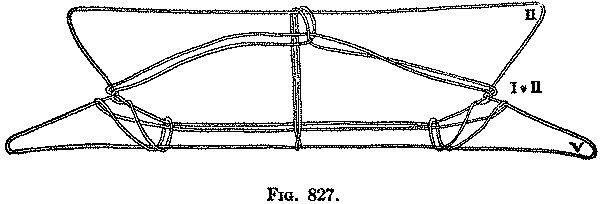
(2) Representation of a mat (Fig. 828).
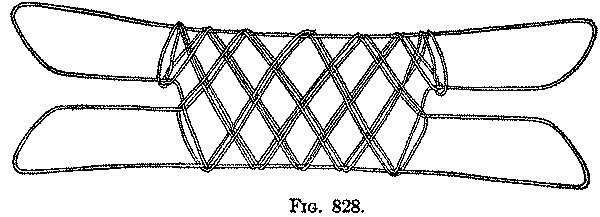
(3) Egona (1) and Egameang (2) sitting on a stone (3) (Fig. 829).
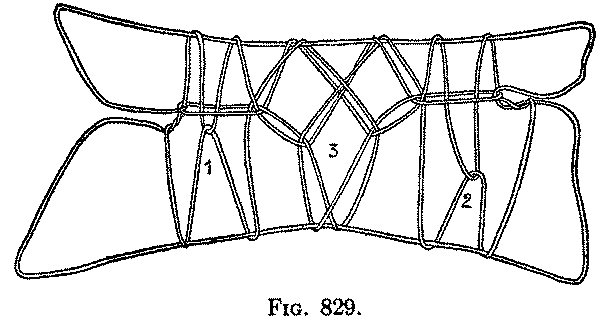
(4) Representation of a mat (Fig. 830).
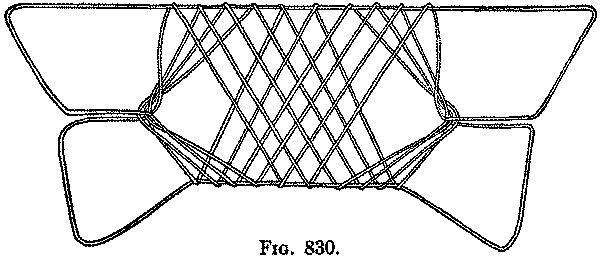
(5) Ijewaioi; a butterfly. The lower loop is held by the teeth (Fig. 831).
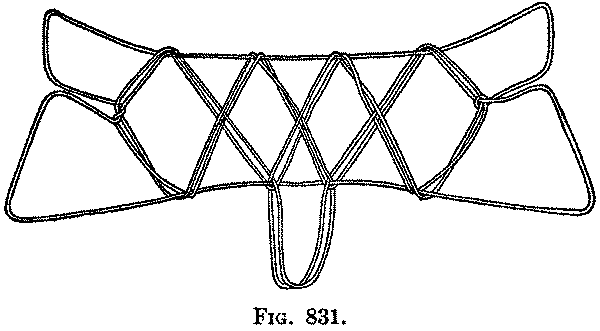
(6) Egattamma; a woman (Figure 832).
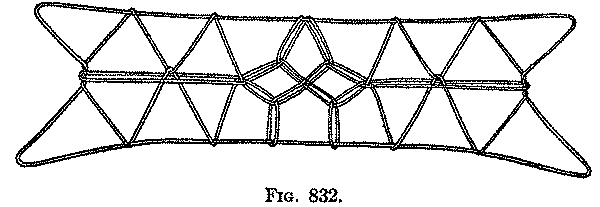
(7) Representation of a mat (Fig. 833).

(8) Etima (1) and Etowa (2); Nauru women of rank (Fig. 834).
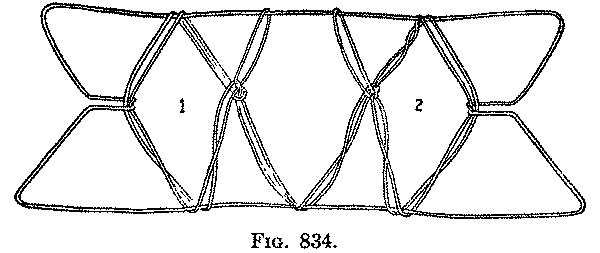
(9) Echeog (1) and Edawaroi (2); two women (Fig. 835).

(10) Representation of a mat (Fig. 836).
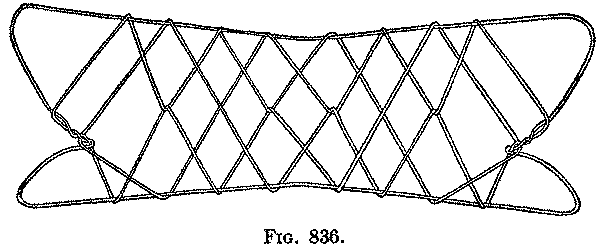
(11) Iiyanibongo; a seasnake (Fig. 837).
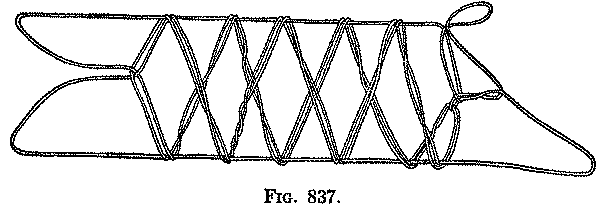
(12) Etaroking; a priestess of Nauru in olden times (Fig. 838).
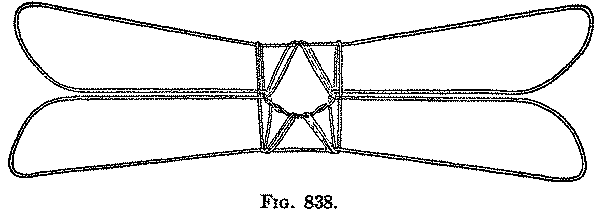
(13) Tinamitto; a Nauru dandy (Fig. 839).

(14) Egarawinago; a lady of quality (Fig. 840).

(15) Ibunemun; a man (Fig. 841).
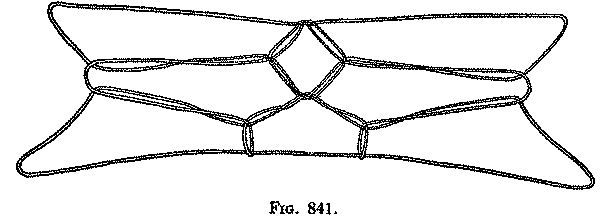
Eskimo Figures
Dr. Boas in his paper on Cat's-Cradle among the Eskimos of Cumberland Sound (1, p. 229) gives drawings of the three following figures:
(1) Ukaliaqdjung = a Hare (Fig. 842). This figure is very like the Eskimo "Cariboo," turned upside down.
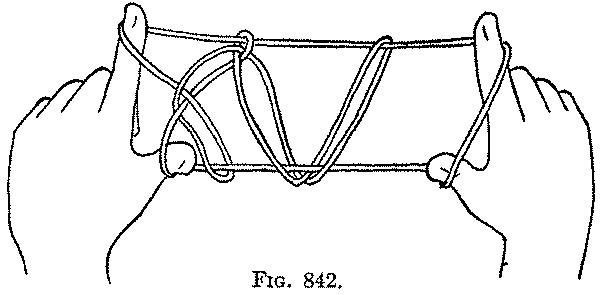
(2) Amaroqdjung = a Wolf (Fig. 843).
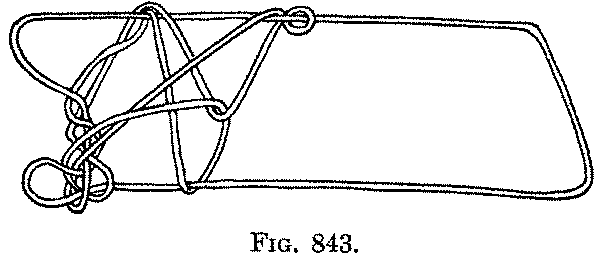
(3) Qaqaqdjung Sesinging = a Hill and two Ponds (Fig. 844).
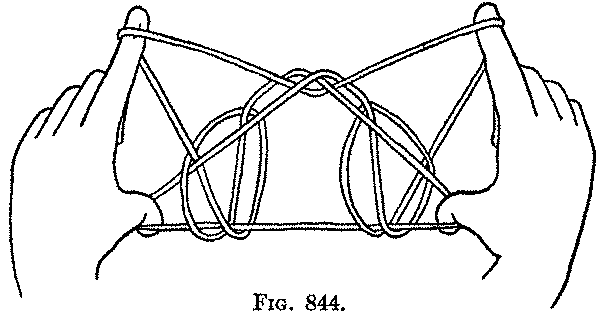
Hawaiian Figures
Mr. Stewart Culin has published drawings of the majority of the Hawaiian patterns preserved in the Philadelphia Free Museum of Science and Art (1. pp. 222-223). I have studied these specimens carefully, but I am unable to give the methods by which they are made; a few seem to be related to stages in our ordinary Cat's-Cradle. Mr. Culin tells us that he obtained them from four Hawaiian sailors from Honolulu, named Aka (Kamehameha), Daviese Kahimoku, Welakahao, and Hale Paka (Harry Park).
(1) Hoo-ko-mo; museum No. 21491, Culin 1, pl. xiv, e. This figure is the same as that produced by the "Bow" opening (Fig. 481).
(2) E-ke-ma-nu; ace of diamonds. No. 21492, Culin 1, pl. xiii, e. This figure is the "Soldier's Bed" of the "Real Cat's-Cradle" (Fig. 845).
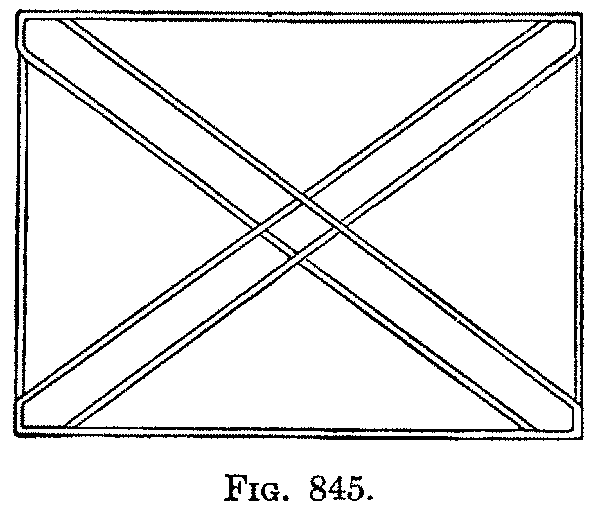
(3) Ma-hi-ki; see-saw. No. 21494, Culin, 1, pl. xiii, d (Fig. 846).
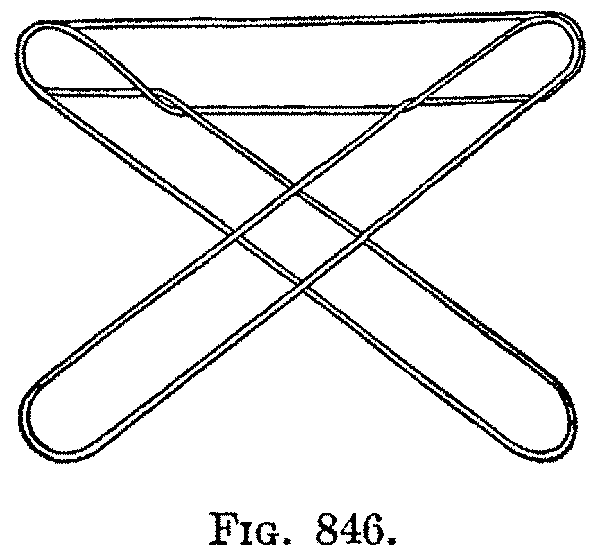
(4) Pou; a post. No. 21451, Culin 1, pl. xv, e (Fig. 847). This figure can be made from the "Bow" opening by transferring the index loops to the little fingers, picking up the near little finger strings with the thumbs and finally slipping the lower thumb loops off the thumbs.
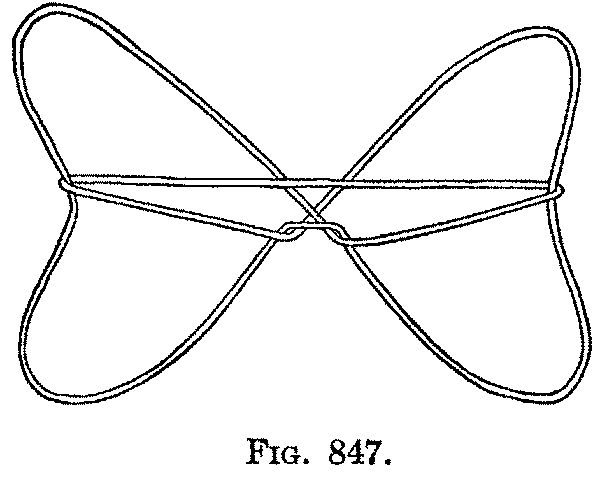
(5) Pau-ma-wai; a pump. No. 21449, Culin 1, pl. xiii, c (Fig. 848).
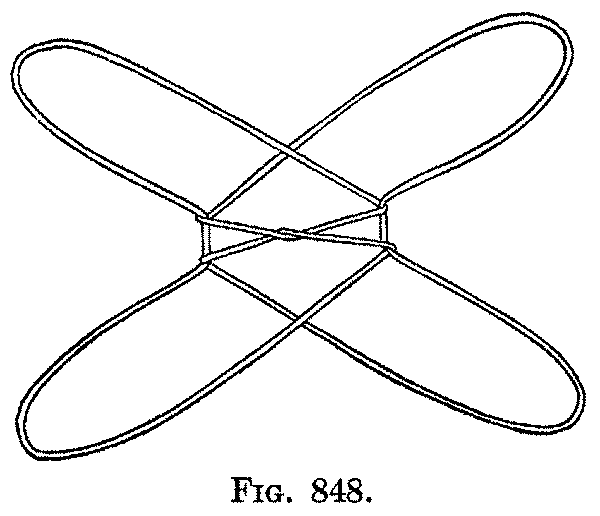
(6) Po; darkness. No. 21495, Culin 1, pl. xiii, b (Fig. 849).

(7) E-ke-pe-ki; ace of spades. No. 21527, Culin 1, pl. xiv, c (Fig. 850).
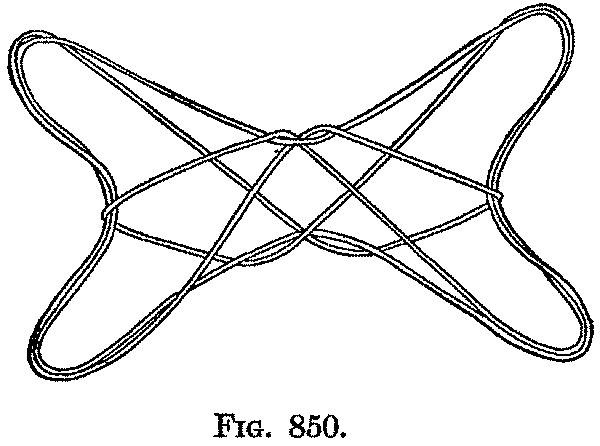
(8) E-ke-ha-ka; ace of hearts. No. 21526, Culin 1, pl. xiii, a (Fig. 851).
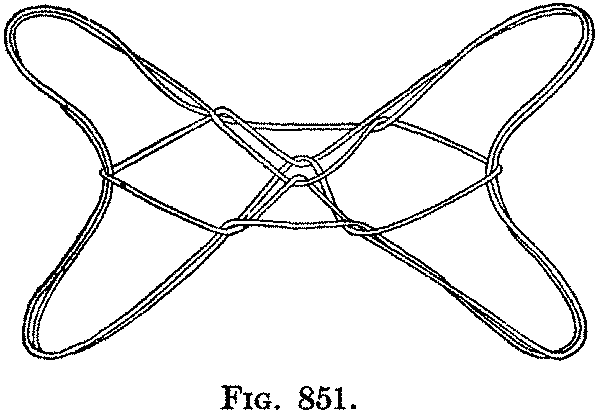
(9) Ma-ka-pe-na. No. 21493 (Fig. 852).

(10) Ko-he. No. 21452. Culin 1, pl. xiv, f (Fig. 853).
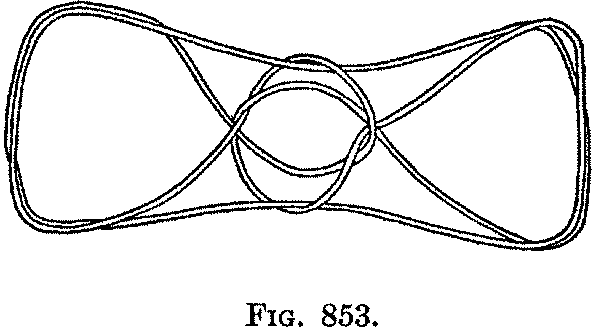
(11) Wai-u-la-wa; the breasts. No. 21496, Culin I, pl. xv, c (Fig. 854).
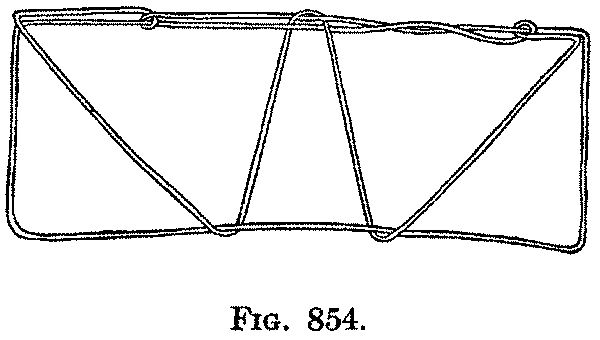
(12) U-pe-na; a net. No. 21498, Culin 1, pl. xiv, b (Fig. 855).

(15) O-ko-le-a-mo. No. 21512, Culin 1, pl. xiv, d (Fig. 856).
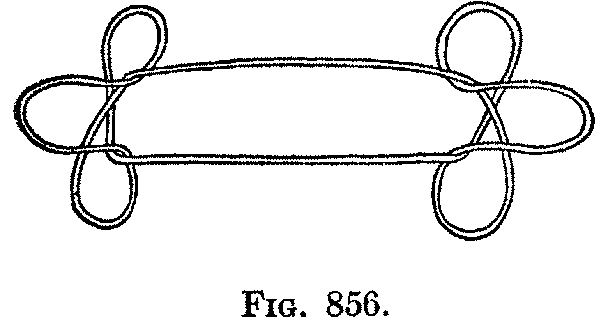
(14) Pa-hi-o-lo; a saw. No. 21450, Culin 1, pl. xv, b (Fig. 857).
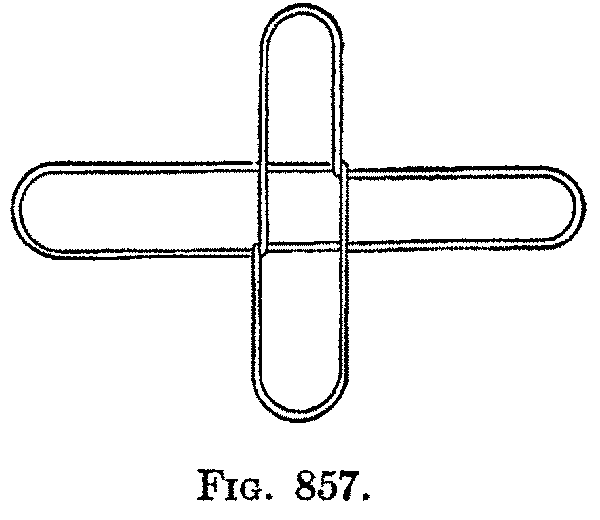
(15) Pu. No. 21513 (Fig. 858).
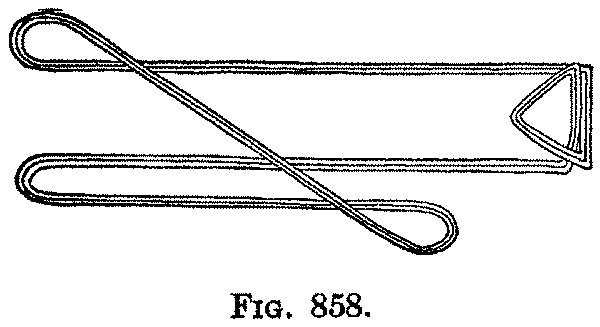
(16) Ha-le-ku-mu-ma-ka-a. No. 21515 (Fig. 859).
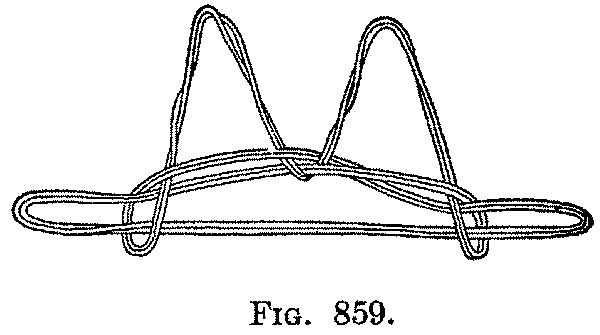
(17) A-ha-ma-ka. No. 21452. This figure is so distorted that I cannot make it out.
(18) A-na-ma-nu; a bird house. Culin 1, pl. xv, a. This figure is similar to the Zuñi "Top cross beam of a ladder" (Fig. 860), except that the two middle strings are not crossed.
A Figure from Zuñi, New Mexico
I have been able to identify most of the figures from Zuñi preserved in the Philadelphia Free Museum. One, however, appears to be new, or is a stage in the formation of another pattern: Tslem-pis-to-nai, pi-cho-wai-nai = the top cross beam of a ladder. No. 22609 (Fig. 860).
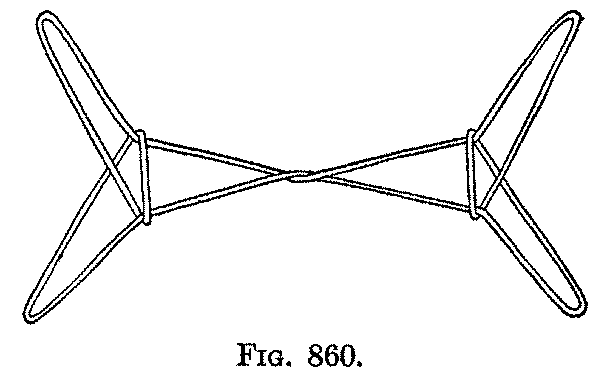
Australian Figures
Mr. Walter E. Roth (p. 10) has published drawings of the finished patterns of seventy-four string figures made by the different tribes of Blacks in North Queensland. I have reproduced his ten plates containing these drawings in order that they may be compared with the figures I have described. It will be observed that, as a rule, these patterns are not very elaborate, and that, contrary to what we should expect, they are not similar to the Torres Straits figures Dr. Haddon has collected. Indeed, some of them are closely related to figures obtained by Dr. Furness in the Caroline Islands. For example: "Ten Men" (pl. vi, 7); "One Chief" (pl. v, 5); "Flint and Steel" (pl. vi, 3); "A House" (pl. xii, 4, 5); "Two Chiefs" (pl. iii, 1, pl. v, 4); the second movement of "Carrying Money" (pl. x, 1). One figure appears to be the same as "The Leashing of Lochiel's Dogs" (pl. xii, 1); others resemble the "Storm Clouds" (pl. ix, 2), and the result produced by exchanging index loops after Opening A (pl. v, 6). It does not follow, however, that the figures are formed by the same movements.
Roth's Plate III--Mankind. Animals
Roth's Plate IV.--Animals: Quadrupeds and Birds
Roth's Plate V.--Animals: Birds
Roth's Plate VI.--Animals: Reptiles
Roth's Plate VII.--Animals: Reptiles and Fish
Roth's Plate VIII.--Animals: Crustacea and Insects. Plants
Roth's Plate X.--Inorganic Nature
Roth's Plate XI.--Inorganic Nature (Continued). Manufactured Articles